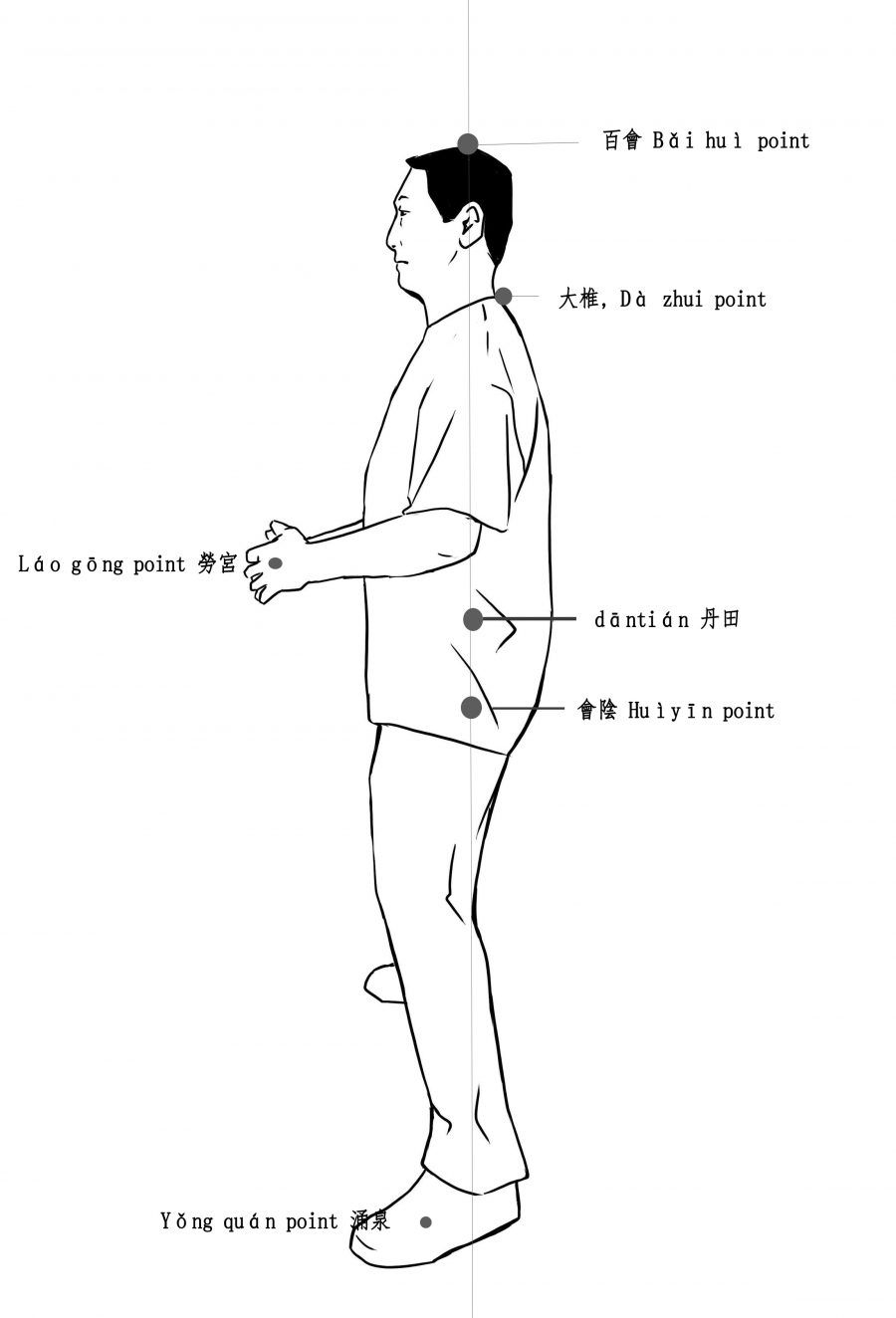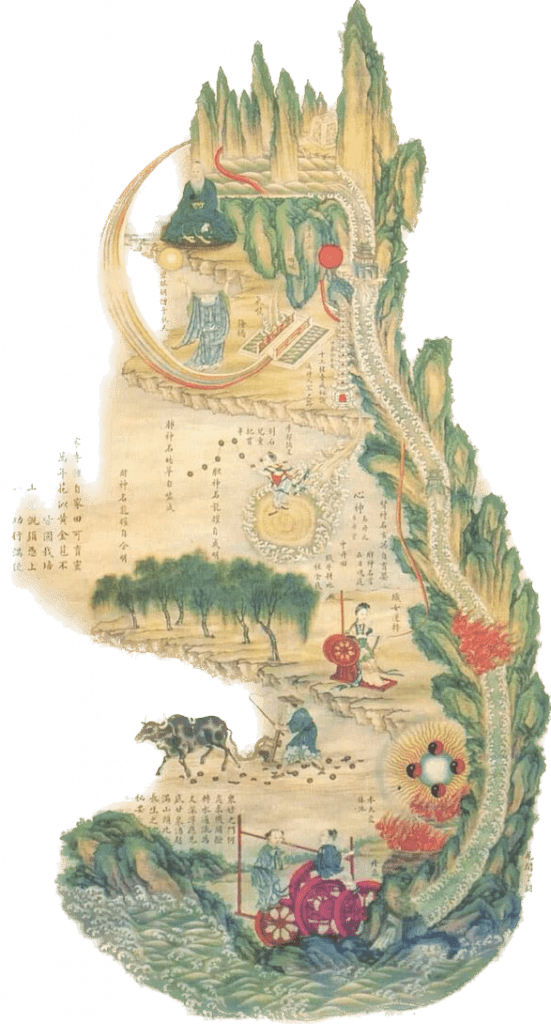
Meridian Theory within Qigong & Taiji
In taiji, everything is circular
I have always wondered why instructors ask you to place the tip of your tongue to the roof of your mouth behind your front teeth: and the following is my understanding of it so far. I am by no means an expert – there are many sources on the internet that one can read in much more detail.
Circular breathing: Small Circulatory Cycle 小周天, Xiǎo zhōu tiān
In Azi School of Taiji we are asked to practise “circular breathing”, as I call it. This is when you breathe in through your nose, down the centre front of your body to your dantian 丹田. On exhaling, you breath out and down to your perineum, coming up your back along your spine to the base at the back of your neck, the 大椎, Dà zhuí point, before following the circle again on the next breath in down your front.
The opposite end is the harder to achieve as you need to use your breath, fascia and intention 意 Yi to bridge a connection between your perineum 會陰 Huìyīn point and your tailbone. We are told not to force this issue, and it will come in time.
The easiest connection to achieve between these two meridians is found at the top; where the tip of your tongue touches the roof of your mouth behind your teeth.
This circle is known as the Microcosmic Orbit according to practitioners of QiGong 氣功. We refer to it as 小周天, Xiǎo zhōu tiān, small circulatory cycle.
There is also the big circulatory cycle 大周天, Dà zhōu tiān, but more on that later.
In terms of meridians; by linking of your Ren meridian 任脈, Rèn mài, Conception Vessel, which is in front of your body, and the Du meridian 督脉, Dū mài, Governing Vessel, on your back, we form a “circle”. This circle when formed allows for further easier connections to all other meridians in your body. Think of this as the ring road around a city, allowing for continuous traffic flow, alleviating congestion in the city centre, and allowing for easier access. The better the functioning of our circle, the better our health. By breathing in this way, you move your qi 氣 around your body.
To achieve this link, the structure of your body needs to be correctly aligned, the opening of the meridians, otherwise you may spend a lot of time practising without much or any gain.

Taiji is qigong – qigong is not taiji
By practising taiji we are practising qigong. We are constantly reminded in class to relax (let go), open up our joints – why? So that we open our meridians and allow the qi to flow around our body. We are then asked to achieve whole body movement – why? So that we can move the qi around our body as effectively and as efficiently as possible.
I now understand why we get a puzzled look when we make a specific request to practise qigong – we are already practising it constantly when we practise taiji!
In practising the taiji form, you are practising qigong with movement. There are other moving qigong exercises, like ‘Eight Pieces of Silk Brocade’ which according, to some opinions, are more for health. Whereas in this school we practise taiji, and thus qigong here is ultimately for a martial goal. Though we fully get the health benefits as well.
As we move our qi around our body during the form, we are focussing more on the external meridian pathways, or the surface meridians, rather than the internal meridians, the organs, though of course they are not mutually exclusive.
It’s a complicated process; maintain your structure, move without blocking the meridians, control your qi with circular breathing, and move with intent.
Foundation Qi Gong
Zhàn zhuāng (站樁/站桩, standing stake) is a typical practice many associate with qigong practice. This is the foundation of qigong – as movement is not involved. Understanding the structure of how the body is held during practice is key, with the correct structure, the meridians points are aligned allowing for easier qi movement.
A lot is mentioned about suspending the head to the sky – this is in relation to your 百會 Bǎi huì point, your connection to the “heavens”. Keeping the back straight and tucking your bottom in, the closing of your kua (let me explain the kua concept in a separate article), enables the two points to line up, your 會陰 Huìyīn point to your Bǎi huì point. The Huìyīn point is your connection to earth. Once aligned your qi is able to travel along a direct path – part of the du meridian.
The most important aspect is to get your structure correct otherwise you could be practising for hours with zero progress. The first emphasis? Open your meridians. How? Let go, relax.
This is foundation qi gong, the movement aspect is removed to make it simpler.
There is so much information on Qi Gong on the internet, I find it sometimes confusing, so for myself I will stick to the basics.

Intentional Qi movement
Once whole body movement is achieved we can introduce intentional qi movement. This is when we direct it to specific parts of the body. The obvious target for martial arts taiji being our hands; the Láo gōng points (勞宮 Palace of Toil). What is less obvious is the “other end”, our feet, where the Yǒng quán points (涌泉 Gushing spring) are located This is the kidney meridian and often known as kidney 1.
At a much higher level of taiji attainment, one can incorporate the big circulatory cycle 大周天, Dà zhōu tiān.
Big Circulatory Cycle 大周天, Dà zhōu tiān.
For this, we follow the path as with the small circular breathing, breathing in through your nose, down the centre front of your body to your dan tian. As you breathe out and down to your perineum 會陰 Huìyīn point. From here instead of continuing up your back, you breathe out down to your feet and then back up to your perineum. The path down and up your legs may be along the inside or outside of your legs. Personally, I simplify the path and breathe out from my dan tian and just straight down my legs, whichever way is the simplest on the day.
Once back to your perineum, follow the small circulatory path up your back along your spine to the base at the back of your neck, 大椎, Dà zhuí point. From this point instead of returning down the front of your body, breathe out down your arms to your fingers and back again before following the circle again on the next breath down your front.
I’ve managed a handful of times to breathe using the Big Circulatory Cycle during form/tao lu practice, but I am still a novice and though I have intent, there is no guarantee that I will achieve it at each attempt.
Understanding, Practice and Progress
All meridians have an internal & external pathway, and a direction of flow. They are also more active depending on the time of day, and link to specific organ functions of the body. Additionally they are also linked to the five elements – earth, fire, water, wood & metal, and have yin and yang aspects. For example, the large intestine and lungs are both metal elements, but the large intestine is yang while the lung is yin. Broadly speaking, we can define yin and yang organs by those that are “hollow” – allowing things to pass through, which makes them yang, and those that are “solid” – containing, which makes them yin.
Keeping this in mind when we practise taiji, by breathing into our body in the most efficient and effective way, we can besides directing qi with martial intent (both in attacking & as a defence), also hopefully heal and maintain our organs’ health.
As students of taiji, we continue to practise moving our qi to our hands, in particular during fa jin. The speed at which an individual develops on this path will differ from person to person. Some may progress quickly jumping forward, others may take a slower and steadier path. As most of us are nowhere near the level of Master Yazi Liu, giving him feedback on your path of discovery is a good way for him to figure out where in the path you are at. When you finally pass his “foundation” level, he will begin to guide you further.
Resources
Some possible interesting reading material if you would like more detail on meridian theory:
The Web that has No Weaver by Ted Kaptchuk
Foundations of Chinese Medicine by Giovanni Maciocia
Other interesting reads:
Breath: The New Science of a Lost Art by James Nestor